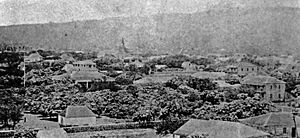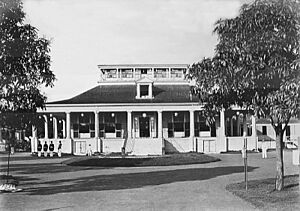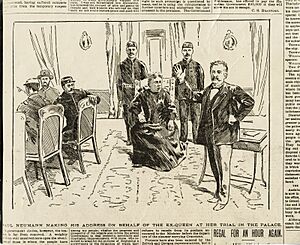ʻIolani Palace facts for kids
|
ʻIolani Palace
|
|
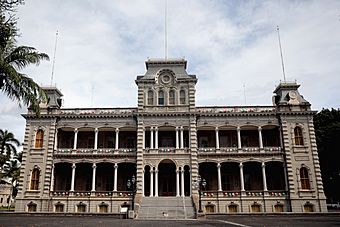
ʻIolani Palace is the hallmark of Hawaiian renaissance architecture
|
|
| Location | Honolulu, HI |
|---|---|
| Area | 10.6 acres (4.3 ha) |
| Built | 1845 (original) 1879 (current) |
| Architect | Thomas J. Baker, Charles J. Wall, Isaac Moore |
| Architectural style | American Florentine |
| Part of | Hawaii Capital Historic District (ID78001020) |
| NRHP reference No. | 66000293 |
Quick facts for kids Significant dates |
|
| Added to NRHP | October 15, 1966 |
| Designated NHL | December 29, 1962 |
The ʻIolani Palace (which means Hale Aliʻi ʻIolani in Hawaiian) was once the special home for the kings and queens of the Kingdom of Hawaiʻi. It was used by rulers from Kamehameha III in 1845 to Queen Liliʻuokalani in 1893.
This important building is located in downtown Honolulu in Hawaiʻi. Today, it is a National Historic Landmark, meaning it's a very special place in American history. After the Hawaiian monarchy was overthrown in 1893, the palace became the main government building for Hawaiʻi. It served as the capitol for different governments until 1969. The palace was later fixed up and opened as a museum in 1978. It's the only royal palace in the United States!
Contents
A Look Back: Early History of the Palace Grounds
Pohukaina: An Ancient Burial Site
Long ago, in the early 1800s, the land where ʻIolani Palace now stands was near an old burial ground called Pohukaina. People believed it was named after a chief who chose a cave as his resting place. This land was owned by Kekauluohi, an important leader known as the Kuhina Nui. She lived there with her husband, Charles Kanaina.
Other important chiefs, like Kekūanaōʻa, also had homes nearby. These chiefs were all part of the House of Kamehameha, a powerful royal family. Their homes were made up of several small buildings for different uses.
The Royal Tomb
Pohukaina was a sacred place where the aliʻi (the Hawaiian ruling class) were buried. In 1825, the first Western-style royal tomb was built here. It was for King Kamehameha II and his queen, Kamāmalu, who were buried on August 23, 1825. The tomb looked like a small house made of coral blocks with a thatched roof. Two chiefs guarded its iron-locked door day and night.
As more royal family members passed away, the tomb became too full. So, in 1865, eighteen coffins were moved to a new, larger royal burial place called Mauna ʻAla in Nuʻuanu Valley. However, many important chiefs still rest at Pohukaina. Today, a metal fence and a plaque mark this historic site.
Hale Aliʻi: The First Royal Home
In 1844, Chief Kekūanaōʻa started building a large house on this site. He planned it as a gift for his daughter, Victoria Kamāmalu. However, King Kamehameha III bought the estate instead. He made it his royal home when he moved the capital of the kingdom to Honolulu in 1845. This house became the first ʻIolani Palace.
This first building was called Hale Aliʻi, which means "House of the Chiefs." It was made of wood and stone, but it was much smaller than the palace we see today. It had special rooms for meetings and dining, but no sleeping rooms. The king preferred to sleep in a cooler grass hut nearby.
ʻIolani Palace Gets Its Name
Later, during the rule of Kamehameha V, the name of Hale Aliʻi was changed to ʻIolani Palace. This new name honored his brother, Kamehameha IV, whose middle name was ʻIolani. The word "ʻIolani" refers to the ʻIo, a royal hawk.
The palace was the official home for several Hawaiian monarchs. Even though it was simpler than today's palace, it was the grandest house in Honolulu at the time. It was mainly used for important events and welcoming visitors from other countries.
The Center of Government
In 1845, King Kamehameha III moved the royal court and the capital of Hawaiʻi to Honolulu. Hale Aliʻi then became the main place for the government. It stayed that way through the reigns of several kings. Even after the monarchy was overthrown, ʻIolani Palace continued to be the seat of government. It was even called "The Capitol of the Territorial Government" for a while. This area was very important culturally, connecting Hawaiʻi's ancient past with its new monarchy.
Kalākaua's Grand New Palace
By the time King Kalākaua became ruler, the first ʻIolani Palace was old and damaged. So, he decided to tear it down. King Kalākaua had traveled the world and seen many grand palaces in Europe. He dreamed of a royal palace that would show Hawaiʻi as a modern and important kingdom.
He wanted a palace that would impress visitors and show the strength of his nation. So, he ordered the building of a brand new ʻIolani Palace. This new palace was built right across the street from another important government building, [[Aliʻiōlani Hale]].
Building a Royal Masterpiece
Three architects helped design the new palace: Thomas J. Baker, Charles J. Wall, and Isaac Moore. The first stone was laid on December 31, 1879. The palace was built with brick and covered with concrete. It was finished in November 1882 and cost a lot of money for that time – over $340,000!
The palace is about 140 feet long and 100 feet wide, standing 54 feet tall. It has four corner towers and two in the middle that rise even higher. On February 12, 1883, a fancy European-style coronation ceremony was held for King Kalākaua. The special building used for the coronation was later moved and became a bandstand for the Royal Hawaiian Band.
ʻIolani Palace has a unique architectural style called "American Florentine." Inside, there's a grand hall with a beautiful staircase made of koa wood. The rooms are decorated with fancy plaster. On the first floor, you can find the throne room, a blue meeting room, and the dining room. The blue room had a large painting of King Louis Philippe of France and a koa wood piano where Queen Liliʻuokalani played music. Upstairs were the private library and the bedrooms of the Hawaiian monarchs.
This palace was the official home for the Hawaiian monarchs until the kingdom was overthrown in 1893. After that, Queen Liliʻuokalani and other royal family members had to leave the palace. It is still the only official royal residence on U.S. soil.
Queen Liliʻuokalani's Imprisonment
After the monarchy was overthrown in 1893, soldiers from the new government took control of ʻIolani Palace. Government offices moved in, and the building was renamed the "Executive Building." The government sold many of the palace's royal furnishings that they didn't need.
Queen Liliʻuokalani was later held prisoner in a small room on the upper floor for nine months in 1895. She made a quilt during this time, which is still in the room, now called the Imprisonment Room or Quilt Room. Her trial was held in what used to be the throne room.
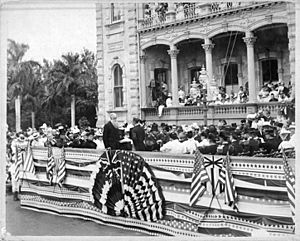
On August 12, 1898, the Flag of the United States was raised at the palace, marking Hawaiʻi's annexation by the U.S. The palace then became the capitol building for the Territory of Hawaiʻi. During World War II, it was even used as a military headquarters. The royal bedroom upstairs became the governor's office, and the legislature met in the former throne room and dining room.
When Queen Liliʻuokalani passed away in 1917, her funeral was held in the palace's throne room.
Hawaiʻi's Important Records
After Hawaiʻi became part of the U.S., people worried that all the kingdom's historical records would be moved away. So, in 1906, a new fireproof building was built on the palace grounds to keep all the important documents safe. It was first called the Hall of Records, but then became known as the Archives of Hawaiʻi. Today, you can even find some of these collections online.
Bringing the Palace Back to Life
Over many years, while it was used as a government building, the palace started to fall apart. In the 1960s, after Hawaiʻi became a state, Governor John A. Burns started a project to restore the palace. The first step was to move the old ʻIolani Barracks building, which now serves as a visitors center.
ʻIolani Palace was recognized as a National Historic Landmark in 1962. Government offices moved out of the palace in 1969 to a new capitol building. Then, the hard work of restoring the palace began. Groups like The Friends of ʻIolani Palace helped research how the palace looked and was used in the 1800s. Many original items were returned, and new fabrics and finishes were made to match the old ones.
Finally, in 1978, after all the restoration work, ʻIolani Palace opened to the public as a museum. In the basement, you can see photos of the palace, royal decorations, and learn about how the palace was restored.
The palace grounds are managed by the state, but the palace building itself is cared for by The Friends of ʻIolani Palace. Birthdays of King Kalākaua and Queen Kapiʻolani are celebrated here with special ceremonies.
ʻIolani Palace is one of the few places in Hawaiʻi where the Hawaiʻi flag can fly alone, without the American flag. This shows its special historical importance.
Recent Events at the Palace
On January 17, 1993, a large event was held at ʻIolani Palace to remember 100 years since the Hawaiian monarchy was overthrown. A special ceremony with torches was held at night, and the palace was draped in black.
In 2008, a group of native Hawaiians called the Hawaiian Kingdom Government gathered at the palace. They were protesting what they believed was unfair rule by the United States. They said they did not recognize Hawaiʻi as a U.S. state and wanted to keep their protest peaceful. The Friends of ʻIolani Palace stated that while they respected the group's right to protest, they believed blocking public access to the palace was not right.
ʻIolani Palace in Movies and TV
The outside of ʻIolani Palace was often shown in the old TV show Hawaii Five-O, pretending to be the police headquarters. It was also used in the TV series Jake and the Fatman as the office for the Honolulu Prosecuting Attorney.
A movie called Princess Kaiulani, about Princess Victoria Kaʻiulani Cleghorn, was filmed at the palace in 2008.
Images for kids
See also
 In Spanish: Palacio 'Iolani para niños
In Spanish: Palacio 'Iolani para niños


